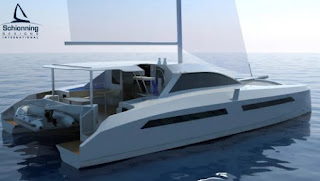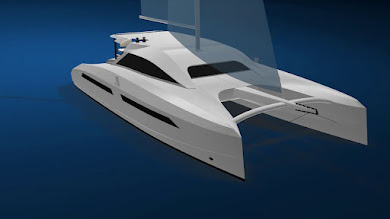Trash. It is a big problem, for a sailboat… and the world.
Planet Earth is turning into a giant trash bin.
Everywhere you go, even the remotest island
in the world, there is trash.
Even if
people are not there tossing it on the ground, our trash washes up on
shore.
It is a disgrace to the human
race.
So, as sailors, how do we become
part of the solution instead of adding to the problem?
On S/V Lynx, we plan to attack
this from two directions.
First off, we will not become part of the problem and, secondly, we plan to work to reduce the amount of trash left by
others.
Below you can read about how we plan to attach these two things, starting with picking up trash.
Picking up
Trash:
Every time we go to a new beach, or if we see trash floating, we plan to pick up trash
and then dispose of it properly. The sad
fact is, doing so will not put a dent, not even a tiny scratch, in the epic
mass of trash infesting our waters and shores.
If what we do will not make a difference, then why try to clean up trash
at all? The answer is simple. If everyone picked up more trash than they put
down, there would be no trash around the world.
Of course, we cannot make others pick up trash, but we can do our little
part, and will.
How do we
handle our own trash?
OK, now let’s talk about
how we can help by not adding our own trash.
The issue is non-degradable waste. When you buy groceries, unless it is a fruit
or vegetable, the purchase likely comes in a container.
Some stores even wrap fruits and vegetables in plastic or put them in a plastic box. The same thing goes for buying meats.
Wrappings and boxes can be made of metal, glass, paper,
cardboard, or plastic. It is obvious, or
should be, that any form of plastic is non-biodegradable and should never be
tossed in the ocean. Paper wrappings may
have a plastic coating, also making them non-degradable.
As for glass, it takes
a long time to break down glass.
And
even though it does not have the same issues as plastic, it can end up on a
beach and become a health issue (broken glass).
Some say that it is all right to fill a glass bottle so that it sinks to
the bottom of the ocean, yet we disagree.
Glass should be properly disposed of, hopefully, recycled.
And what about
aluminum or tin cans?
Aluminum cans will take something like 200 years to break
down, and they are most often coated on the inside in plastic. Therefore, they should be recycled and never
tossed in the ocean.
Tin cans also often have a plastic inner coating, so they should also be recycled.
So, what can you
toss in the ocean without guilt or adding to pollution?
Fruit and vegetable parts, like rinds, and paper (without plastic
linings).
Both of these break down in various
ways.
What about cardboard?
Yes, this is paper and can be put in the ocean to break down... but, the truth is, you should not bring cardboard on board in the first place! The
issue here is cockroaches. They lay eggs
on the sides of cardboard, so if you do not want your boat infested with cucaracha,
then you should not bring cardboard on board, so to speak.
So how do you bring some foods if you cannot bring it in their original container? The answer is simple, you need to remove all
foods from their cardboard, plastic, or other container and move them into a
new one. Or just choose not to bring
those types of food or drink at all.
An example of this would be canned or plastic bottle soft
drinks or beer. Instead of having to store empty cans and bottles, or toss them overboard (shame on you) choose to buy a soft
drink machine that fills a reusable cup or glass when you want your fizzy,
sweet, sugar drink. As for beer, you're on your own, we don't plan to have any on S/V Lynx. We plan to give up both soft drinks and beer and
switch to another healthier beverage to drink.
Reusable Containers
Let’s get back to disposing
of the original box or plastic bag and switching to your own storage device.
What you want to have are reusable
containers.
These can be glass or
plastic because you are not going to dispose of them when they are empty, you
are going to clean them out and reuse them again the next time you are in port
provisioning.
You can use zip lock bags, though we recommend getting a
thicker and longer lasting variety if you go that route.
We prefer hard sided storage that lasts much
longer.
These can be sealable soft
plastic containers, or hard plastic models.
Find ones that fit together and stack on each other and are sized to fit
in your storage areas.
Stay away from
round models, if possible, they just create more gaps.
Use labels you can change on the tops or sides (depending on the storage
compartment).
When you do change a label,
make sure to dispose of the old one properly!
Instead of some kind
of plastic wrap, you can get shower cap style plastic tops that snap over bowls
and are completely reusable.
Or just
move the food out of the bowl or plate into a sealable, reusable container.
Bringing provisions on boardTo cut down on trash (and bugs) we suggest a routine where you arrive on the dock with your
newly purchase provisions, but don't take them onto your boat yet. Take a bucket
of fresh water and add in a small cap-full of bleach. Then wash your fruits and vegetables before
bringing them (and any cockroach eggs) on board. Put any foods previously contained in cardboard into a sealable reusable container.
Pile the discarded cardboard together for recycling on shore. Remove any foods, like cereal, that are in a
plastic bag and put them into another sealable reusable container.
Now we come to a
problem; we're talking about foods stored under pressure or sealed to make them last longer.
Some of these foods can be transferred into
a food sealing container where you use a food sealer machine to suck the air back out.
However, there are just some
things that have to stay in their container to keep them fresh for a long
time.
While still on the dock take each jar or can, one
at a time, and remove any paper labels. Set these aside for the
moment to be disposed of properly, on shore, later. This is to avoid cockroach eggs again. Now wash that can or glass item in your bucket. Once you dry it off, mark the item with a permanent
ink pen, showing what it contains (if you forget, look at that label you just set
aside). Do this one can or jar at a time so you do
not forget what is in each one! Once used, these containers
must be kept in a trash bag and disposed of or recycled at your
next port of call.
Unless the container is a can or glass jar under pressure or
sealed, no plastic, paper, glass, or cardboard should be brought on board.
For example, if bread comes in plastic bag,
remove the bag and put the bread I a long reusable and sealable container (they
make specific ones for loaves of bread).
When you are far out to sea, meaning not in a marina, port, or near a beach. In that case, it is OK to toss the rinds or other scraps of fruits or vegetables overboard. The reason you do not want to do this near
shore is that no one wants to see your stuff floating around or washed up on
the beach before it degrades.
If you do not use all of something, reseal the container (food
sealing what is appropriate, since that will make it will last longer without air inside). If you need to temporarily store something on
a plate or bowl, just put on the shower cap style reusable wrap. As your containers empty, just put them back
in the place you keep them and mark your list to refill them later at the next
provisioning.
If you follow these
practices, you will bring on a minimum of containers needing to be disposed of or recycled later, with most of your foods being kept in reusable
containers.
You will also benefit from
avoiding cockroaches on board, which is no small thing. This is not a cure all for cockroaches, but
why give them any added chance to get on board?
While on the subject,
what about things like shampoo, or other items that come in plastic? Buy reusable dispensers and pour the products into those, then recycle the original plastic on shore before you set sail. We suggest you try to buy the kind that have the flat lids that allow you to stand them upside down. Then, you can pour out the contents, stand it upside down for a few hours, and pour the remaining product into your reusable container.
Other items, like spare parts, new gadgets, or any other purchases that come in any kind of container, should be handled the same way as your food
items. Simply put, do not bring any
cardboard or plastic on board. Take the items
out of their containers or packaging, label them in the new reusable container and store them that way.
When you look at any
item you are bringing on your boat, just ask, yourself, when I go to use this item,
will I have trash left over?
If so, get
rid of that trash, properly, before bringing it on board.
If you try to cut down on things that become
trash you will have far less bags of trash stored on board that you must. eventually, ferry to store in your dinghy.
Be proactive, do not drown your boat (or worse, the ocean)
in trash.
Food Sealers
What about food sealer systems?
Well, we are a fan of these.
They help keep food fresh for
much
longer.
However, you should avoid using
the plastic food sealing bags that are not reusable.
When possible, go with hard containers that can be reused
over and over again, without creating plastic waste.
Even if you must use the plastic sealing bags, plan to wash
and reuse these items.
To make them somewhat
more reusable, cut the original bag a little longer than you need.
When you go to use the item stored in the
bag, cut off a thin strip of the plastic at the top, just below the melted seal.
That way, you may wash and reseal the same plastic sealing bag with your food sealing device. The small
strip you cut off becomes trash that you must store until you reach shore for proper
disposal, which is why we prefer the hard sided food sealing containers… where there is no waste. However, there are items that work better in
the bags. Just be aware that these bags must
be disposed of properly, later.
Some things can be put into reusable zip lock bags instead
of being food sealed. Things like liquid
items that you can remove the air without a food sealer. Just reuse those zip lock bags as many times
as possible and then properly dispose of them later.
The moral of the
story?
Do not bring trash on board in
the first place, when possible.
Dispose
of that trash on shore, properly.
Any
small amounts of trash that is unavoidable, store and dispose of properly
later.
This should be easy if you have
cut down most of the other trash that does not need to be on board in the first
place.
Yeah, some of these suggestions are a minor hassle, but if
we all do not start going the extra mile, then our planet will continue to be
buried in trash. We think it is worth our
time… and everyone’s.
Oh, and the next time you see someone else’s trash, pick it
up and dispose of it properly. We all
have to start making a difference.
 Back in April, I made a Blog post about different hybrid propulsion systems, and how we chose a parallel system for the comfortable production catamaran we planned to purchase, used. Times have changed. Used cat prices went through the roof, so we decided to build a catamaran, ourselves! We are in the process of constructing a new 50' performance catamaran. With that change in the type of boat we will sail around the planet, we had to re-evaluate which propulsion system would best suit this new performance cat.
Back in April, I made a Blog post about different hybrid propulsion systems, and how we chose a parallel system for the comfortable production catamaran we planned to purchase, used. Times have changed. Used cat prices went through the roof, so we decided to build a catamaran, ourselves! We are in the process of constructing a new 50' performance catamaran. With that change in the type of boat we will sail around the planet, we had to re-evaluate which propulsion system would best suit this new performance cat.

















































